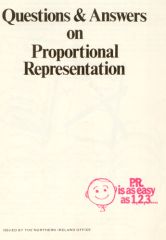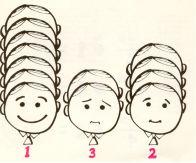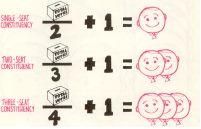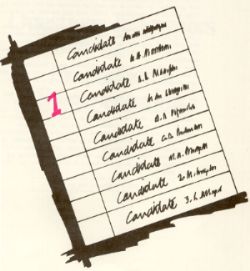 CAIN Web Service
CAIN Web Service
NIO (1973) 'Questions & Answers on Proportional Representation'
[CAIN_Home]
[Key_Events]
[KEY_ISSUES]
[Conflict_Background]
POLITICS:
[Menu]
[Reading]
[Articles]
[Government]
[Political_Initiatives]
[Political_Solutions]
[Parties]
[ELECTIONS]
[Polls]
[Sources]
[Peace_Process]
Text: Northern Ireland Office Page Compiled: Brendan Lynn

Questions & Answers
on
Proportional
Representation
Issued by the Northern Ireland Office
1. What is PR?
It is an electoral system designed to make sure that the candidates elected represent accurately the opinions of the voters, i.e., that the strength of each party in the assembly or council is in proportion to its support among the people. The system to be used in the coming elections is called the Single Transferable Vote, STV for short. Every voter has only one vote, but he can ask for it to be transferred from one candidate to another to make sure it is not wasted. He does this by numbering the candidates 1, 2, 3 and so on instead of just putting an X against one of them.

2. Why multi-member Constituencies?
In a single-member constituency, all the votes not cast for the winning candidate are wasted, since they have not been able to elect anyone. And so are all the votes in excess of a bare majority cast for the winner, in the sense that they have had no effect on the result.
Imagine a country where the strengths of the various parties were consistent in every constituency; no opposition candidates could ever be elected. The single-seat majority-vote system works only because parties are stronger in some areas than others, and this is why there is so much difficulty in fixing constituency boundaries.
With PR several candidates are elected together, representing all the sizable bodies of opinion in the constituency, in proportion to their strength. The bigger the constituency, the more chance a small party has of electing a representative. In a 7 seat constituency, for instance, any candidate who gets more than l2 1/2 % of the votes will be elected. (See Section 4 on the quota).
3. How does it work?
One way of visualising a PR election is to think of how a class of children might choose 3 prefects. A number of candidates stand at the front of the room and the children line up behind their favourites. At first the most popular candidate has most of the children behind him, and the least popular only a few. The children at the end of the longest line see their favourite does not need their support, and move behind their second choice; the ones behind the least popular candidate see he has no chance, and they also move behind their second choice.
Finally all the children are ranged in more or less equal numbers behind just 3 of the candidates. Every child has had a part to play in the election, and has seen that his vote counts, even though some of them may not have got exactly what they first wanted.

4. Whats the quota?
The quota is the number of votes a candidate needs to be elected. People often assume that if there are, say, 5 candidates to be elected, the quota must be one-fifth of the total votes cast, or if not that there is something mysterious and complicated about the whole thing. In fact the quota in this case is one-sixth of the total votes cast, plus one vote, and it is clear that this must be so if we think what the quota would be in a single-seat constituency. To be sure of being elected a candidate needs only one more than half the total votes. Similarly in a 2-seat constituency a candidate needs only one-third of the total vote plus one to be sure of being elected. In a 3-seater, one-fourth plus one, and so on. In other words, to find the quota you simply divide the total votes by one more than the number of seats to be filled, and add one vote to the result.
You might now like to work out the quota in the little election described in the last section, assuming 24 children voted. The answer is at the end of this booklet.

5. What happens in the count?
First the total number of valid votes is counted and the quota is worked out. Then the votes are sorted according to the first preferences of the voters. That is, each candidate is allocated every ballot paper on which there is a 1 against his name. Any candidate who is then found to have reached the quota of votes is elected.
Some candidates may then have a surplus over the quota. Others may have so few votes that they can be eliminated from the contest The remaining stages of the count are occupied in transferring these unused votes to other candidates, in accordance with the preferences of the voters, to make sure they are not wasted The surplus votes of candidates who reach the quota are transferred first. Then the lowest candidate is eliminated and his votes transferred. Then any new surplus is distributed. Then another low candidate is eliminated and his votes transferred, and so on, until all the seats are filled. When there are no more preferences expressed on a ballot paper it is retired from the count as "non-transferable" and that voter ceases to have any influence on the result.
6. How will the results be shown?
A statement will be published for each area showing exactly what happened at each stage of the count. It will show the number of First preference" votes for each candidate, and the number of votes transferred to each of them when a surplus is distributed or another candidate is eliminated. It will also show the number of papers which at each stage become non-transferable" because the voters had not expressed enough preferences.
The voter will therefore be able to follow, as it were, the progress of his vote through the count and see how it is working to affect the final result.
7. Are ballot papers actually moved from one pile to another?
Yes. When a candidate is eliminated, for instance, his ballot papers are taken up and added to the piles of the candidates still in the running, in accordance with the voters preferences. Ballot papers which show no further preferences, or preferences only for candidates already eliminated. re put aside as "non-transferable."
8. But when a surplus is being distributed, who decides whether any particular ballot paper is distributed as a surplus, or stays with the elected candidate as part of his quota?
Suppose the quota is 1,000 votes and candidate A gets 1,500 votes in the first count. That means 500 of his votes, a third of his total, are to be re-distributed as surplus. In the counting system used in the 1920s, the 1,500 ballot papers were examined to find out the proportion of second preferences for the other candidates, and then 500 ballot papers were taken at random to reflect that pattern, and distributed among the other candidates.
Some people said, "thats all very well, but how is anyone to be sure that the 500 papers transferred reflect faithfully the pattern of later preferences expressed by the 1,500 people who voted for candidate "A"? They dont matter now, but they might become important later in the count."
It was to meet this objection that a new way of transferring surpluses was devised, sometimes called the Senatorial method because it has been used in elections to the Senates of several countries, including Northern Ireland. The coming elections in Northern Ireland will be the first time it has been used in a general election.
What happens is that instead of transferring one third of the votes, all the 1,500 votes are transferred at one third of their value This does not mean that your vote is actually divided up. It is simply a mathematical way of ensuring that the value of 500 votes is transferred to the candidates to whom they are due in the proper proportion. This explains why there will be fractions of votes shown in the results of the various counts.
9. How many candidates can I vote for?
You only have one vote, so strictly speaking the question should be, how many alternative preferences would I like to express? The answer is that you can number as few or as many candidates as you like. As long as the number 1 is put opposite the name of one candidate your vote is valid, as far as it goes. But you can number every candidate on the ballot paper, no matter how many seats there are to be filled.
10. What is "Plumping?"
This means voting for only one candidate, or restricting your preferences to the candidates of one party.

11. Does "Plumping" help my party?
No. Your vote can only be transferred when your first choice or choices do not need it or cannot use it - i.e., after they are elected or eliminated. So you do not help your favourites by throwing in your hand at that stage. If among the remainder of the candidates there are some you like more than others, or dislike less, you should express preferences for them and thereby influence the election right to the end.
"Plumping" simply wastes your voting paper.
12. Exactly how do I vote?
You should really study the lists of candidates (in the newspapers or the election literature) well beforehand and make up your mind about your preferences among the candidates and parties. There? will probably be quite a number of names on the ballot paper. They will be in alphabetical order, and the parties they belong to will be shown.
When you get your ballot paper, mark the number '1' against the name of the candidate you most wish to see elected. Incidentally the space for marking the ballot paper will be on the left hand side of the paper, not the right hand side as it was in previous elections.
Then ask yourself, if you cannot have your favourite or if he doesnt need your vote, which other candidate you would like to see elected; put a 2 against his name. Then a 3 for your third choice and so on.
Voting in a PR election requires a certain amount of consideration, as indeed such an important matter as voting in any election should. But if voters take the trouble to fill up their ballot papers thoughtfully and carefully they can have the satisfaction of knowing the result will reflect not just a simple negative/positive reaction, but their entire outlook.
| Note on Section 4: the quota was 7. |
|





